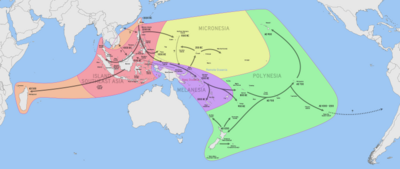
Back الحيوانات والنباتات المستأنسة في أسترونيزيا Arabic Domesticated plants and animals of Austronesia English Tumbuhan dan hewan terdomestikasi di Austronesia ID

Uno de los acontecimientos de migración humana más importantes fue el asentamiento marítimo de las islas del Indo-Pacífico por los pueblos austronesios, el cual se cree comenzó alrededor de los años 5,500 a 4,000 AP (3500 a 2000 a. C.). Estas migraciones fueron acompañadas por un conjunto de plantas y animales domesticados, semi-domesticados y comensales transportados a través de canoas y catamaranes, los cuales permitieron a los primeros austronesios prosperar en las islas del Sudeste Marítimo de Asia, Oceanía Cercana (Melanesia), Oceanía Remota (Micronesia y Polinesia), Madagascar, y en Las Islas Comoras.[2][3]
Estas especies incluyen cultivos y animales que se creen fueron originados en las culturas Hemudu y Majiabang en las hipotéticas tierras preaustronesias de China continental, así como otras que se creyeron domesticadas primeramente en Taiwán, el Sudeste Marítimo Asiático, y Nueva Guinea.[4][5][6] Algunas de estas plantas son ocasionalmente nombradas como plantas de canoa, especialmente dentro del contexto de las migraciones polinesias.[7][8] Las plantas y los animales domesticados introducidos durante los tiempos históricos no serán incluidos.
- ↑ Chambers, Geoff (2013). «Genetics and the Origins of the Polynesians». eLS. John Wiley & Sons, Inc. ISBN 978-0470016176. doi:10.1002/9780470015902.a0020808.pub2.
- ↑ Bellwood, Peter (2004). «The origins and dispersals of agricultural communities in Southeast Asia». En Glover, Ian; Bellwood, Peter, eds. Southeast Asia: From Prehistory to History. RoutledgeCurzon. pp. 21-40. ISBN 9780415297776.
- ↑ Reilly, Kevin (2012). Volume I: Prehistory to 1450. The Human Journey: A Concise Introduction to World History 1. Rowman & Littlefield Publishers, Inc. pp. 207-209. ISBN 9781442213869.
- ↑ Liu, Li; Chen, Xingcan (2012). «Emergence of social inequality – The middle Neolithic (5000–3000 BC)». The Archaeology of China: From the Late Paleolithic to the Early Bronze Age. Cambridge World Archaeology. Cambridge University Press. p. 204. ISBN 9780521644327. doi:10.1017/CBO9781139015301.007.
- ↑ Bourke, Richard Michael (2009). «History of agriculture in Papua New Guinea». En Bourke, Richard Michael; Harwood, Tracy, eds. Food and Agriculture in Papua New Guinea. ANU E Press. pp. 10-26. ISBN 9781921536618. doi:10.22459/FAPNG.08.2009.
- ↑ Denham, Tim (October 2011). «Early Agriculture and Plant Domestication in New Guinea and Island Southeast Asia». Current Anthropology 52 (S4): S379-S395. doi:10.1086/658682.
- ↑ Kitalong, Ann Hillmann; Ballick, MichaelJ.; Rehuher, Faustina; Besebes, Meked; Hanser, Sholeh; Soaladaob, Kiblas; Ngirchobong, Gemma; Wasisang, Flora et al. (2011). «Plants, people and culture in the villages of Oikull and Ibobang, Republic of Palau». En Liston, Jolie; Clark, Geoffrey; Alexander, eds. Pacific Island Heritage: Archaeology, Identity & Community. Terra Australis 35. ANU E Press. pp. 63-84. ISBN 9781921862489.
- ↑ Theroux, Paul (December 2002). «The Hawaiians». National Geographic 202 (6): 2-41.